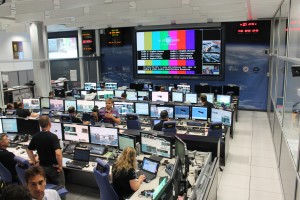Mission Director Jean-Michel Bois recounts first-hand the exciting launch of ATV-5:
Done ! ATV-5 is now in orbit after a successful Ariane 5 mission.
It was another very interesting night at ATV Control Centre (ATV-CC).
We started at ATV-CC at Ho-16 hours, pre-launch activities included verification and preparation of the Ground Segment and its networks followed by the coordinated data transfer between Toulouse and Kourou – everything went smoothly.
As explained in another article by Jean-Christophe, a tropical storm over Guam island forced us to check with Kourou and Houston (a node for the TDRS communications for us) if we were still GO for the launch or not. Communications are fundamental at the beginning of a flight to monitor and control ATV, especially in case of an anomaly.
Countermeasures were identified and put in place to partially solve the issue and the GO was given at H0-5 hours by ESA authorities to continue with the countdown.
To put in place in detail these measures we had to revise all our plans to cope with these new timeline constraints. An urgent meeting was called with the Launch and Early Operations Phase teams to finalise this new schedule.
A new surprise came at H0-2 hours, another warning was sent by our colleagues in Houston to inform us that the main TDRS center in White Sands, New Mexico, might also potentially be affected by a different storm…
At H0-45 minutes, everything returned to nominal status with no more concern regarding the weather at White Sands and our revised schedules were ready to be played out.
Perfect Ariane 5 flight
Regular good news was given to us in real-time by the Arianespace representative located in a room close to ATV-CC and by Massimo Cislaghi, ATV-5 Mission Manager, from the Jupiter room in Kourou. The perfect way to decrease stress on our teams!
20 seconds after the end of the second ignition of the Ariane 5 upper stage, ATV telemetry transmitters are activated, and, yes, we received, as expected, fresh data from ATV-5, all the initialisations of its subsystem had started nominally.
That was a very good start for this mission.
Unfortunately, we rapidly received an alarm from ATV-5 that one of the four electronic boxes driving the propulsion subsystem, called PDEs, became isolated. Several minutes were necessary to establish an uplink to command ATV-5. There were additional things to manage in parallel to normal ATV initialisation.
Thanks to the robust ATV design, the PDE was isolated, and onboard redundancies activated to continue the mission. And due to numerous days of trainings and simulations, the ATV-CC teams were able to cope with this new propulsion configuration, to quickly solve the communication issues and continue the monitoring and commanding of our spacecraft.
Deployment
Around 30 minutes after separation, a perfect deployment occurred of the four solar panels and of the mast supporting the transmitters for the rendezvous with the International Space Station later.
Afterwards, all activities were performed according to our schedule: we started the two GPS receivers, initialisation of the propulsion chains dedicated to the main thruster in charge of the ATV manoeuvres and so on…
H0+7 hours : ATV-5 is in good shape, except for the one PDE, but without consequence on the mission. It is now up to my colleagues to continue with the first phasing manoeuvres to raise ATV-5’s altitude and chase the International Space Station!
It is never a routine task… All missions are different, each with its own surprises. That is the beauty of this job!
Jean-Michel Bois
Mission Director for this LEOP phase


 Automated Transfer Vehicle page
Automated Transfer Vehicle page ATV blog archive
ATV blog archive
 NASA Orion page
NASA Orion page NASA Artemis
NASA Artemis Airbus Orion page
Airbus Orion page
Discussion: no comments